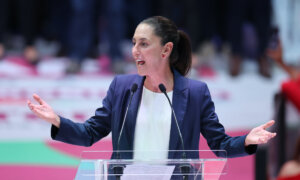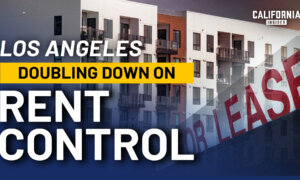Commentary
On March 1, the Berkeley IGS Poll reported, “Garvey Now in a Statistical Tie with Schiff in Full-Term U.S. Senate Primary.” Republican U.S. candidate and former baseball star Steve Garvey scored 27 percent, followed by Democratic Reps. Adam Schiff, Katie Porter, and Barbara Lee garnering 25 percent, 19 percent, and 8 percent, respectively.
Election-day numbers were even closer. Preliminary results from Secretary of State Shirley Weber show: Mr. Schiff 33.2 percent, Mr. Garvey 32.4 percent, Ms. Porter 13.8 percent, and Ms. Lee 7.4 percent.
But if we add up the numbers by party, including numerous minor candidates who got less than 1 percent, we get: Democrats 57.3 percent; Republicans 40.8 percent; the American Independent 0.2 percent; the Libertarian 0.5 percent; No Party Preference 1 percent.
That is similar to almost all recent statewide elections, in which Republicans strain to rise above 40 percent. Mr. Garvey is unlikely to hit any better.
Then there’s voter registration. As of Feb. 20, here’s Ms. Weber’s January statewide numbers tally: 46.59 percent Democrat, 24.41 percent Republican, 21.84 percent No Party Preference, 7.16 percent Other.
If Mr. Garvey catches all 24.41 percent from his fellow Republicans, plus all the 21.84 percent from NPP, he would hit 46.25 percent—still below the 46.59 percent for all Democrats. Mr. Garvey then would have to catch at least 1 percentage point from the Other category, or Democrats who for some reason don’t like Mr. Schiff.

Former baseball player Steve Garvey waves as he is introduced during a Memorial Tribute To Tony Gwynn by the San Diego Padres in San Diego on June 26, 2014. (Stephen Dunn/Getty Images)
Mr. Garvey also has refused so far to say he will vote for President Trump, who after his Super Tuesday victories across the country is the presumptive Republican nominee for president. Yet on Tuesday in California Mr. Trump garnered 78.6 percent of Republican votes. California’s GOP now is MAGA territory.
Unless Mr. Garvey endorses Mr. Trump, Mr. Trump won’t endorse him—which may cost Mr. Garvey Republican votes. The Top Two system prevents a third option from appearing on the November 5 ballot, so some might just leave that part of the ballot blank.
As I detailed in my Feb. 12 Epoch Times article, “What Political Flyers Show Us About California’s March 5 Election,” Mr. Schiff sent out numerous flyers boosting Mr. Garvey’s two previous votes for Mr. Trump. That made sure Mr. Garvey finished second, ahead of Ms. Porter. Mr. Schiff likely will continue that winning strategy, although this time not to boost Mr. Garvey among Republicans, but to ensure anti-Trump Democrats and NPPs stick with Mr. Schiff.
Thus, it’s not looking good for Mr. Garvey. His best strategy probably is to embrace Mr. Trump to keep Republicans from defecting. But if he does that, many NPPs may be turned off.
Again, let me decry Republicans’ inability to focus on getting rid of the Top Two system, perhaps by expanding it to Top Four. There is much disaffection in the Democrat Party for status-quo candidates like Mr. Schiff. In Michigan a week ago, 100,000 Democrats voted “Uncommitted” for president as a protest against President Biden’s policy of supporting Israel in its war with Hamas. Come November, those voters could cost Mr. Biden Michigan’s 15 electoral votes to Mr. Trump, even though the latter also supports Israel’s policy.
If California had a Top Four system, many Democrats disaffected with Mr. Schiff, who is even more supportive of Israel than Mr. Biden, would vote third party, reducing his vote total. That would provide a path for Mr. Garvey, also a strong supporter of Israel, if he were able to achieve 40 percent or so of the vote. But that is not to be this year because of the anti-democracy Top Two system.
Prop. 1 Bond Vote Damaging Newsom
As I write, Proposition 1 is barely winning with just 50.2 percent of the vote. That could change in the coming days and weeks. It would spend $6.4 billion on mental health and housing programs for the homeless. The official ballot language said it would cost $300 million a year from the state’s general fund.
But as I wrote in my Epoch Times analysis from Jan. 22, the real cost will be $600 million a year. And I pointed out my longtime saying: Bonds are delayed tax increases. The money has to come from somewhere.

California Gov. Gavin Newsom announces the 2024 ballot initiative to treat people at risk of homelessness and with mental illness and drug addiction across the state at Alvarado Hospital in San Diego on March 19, 2023. (Courtesy of Office of Governor Gavin Newsom)
But here’s what’s interesting: Ballotpedia tallied $14.3 million for the Yes on Prop. 1 side. That mainly included $13.4 billion from “Newsom’s Ballot Measure Committee; Yes on Prop 1.” But the No side raised only $1,000. Almost nothing.
Gov. Gavin Newsom closely tied his name to promoting the measure. He knows his national stature for a future presidential run depends on him doing something, anything, to reduce the international disgrace of the state’s homelessness crisis. In last December’s PPIC poll, it was supported by two-thirds of likely voters. And in its latest poll, from Feb. 27, Prop. 1 still grabbed 59 percent support.
It may be voters are upset with Mr. Newsom’s mishandling of the state—not just the homelessness, but the projected $73 billion deficit, the rise of crime, and his grandstanding around the country for his Oval Office ambitions. Maybe they have become suspicious of anything he proposes.
The close vote, even if Prop. 1 wins, will fuel proponents of a second recall attempt by Rescue California, the same outfit that put a recall against him on the ballot in 2021. It lost that time, with 62 percent voting No. Previously, in 2018, he had won the governorship by the same number, 62 percent. But his 2022 reelection bid won him only 59 percent.
Although Mr. Newsom as lieutenant governor from 2011 to 2019 sat next to Gov. Jerry Brown, he didn’t learn that veteran’s frugality with the budget and attention to the details of state problems.
Former state Sen. John Moorlach (R-Costa Mesa) was in office 2015-2020, and his Capitol office was directly above that of the lieutenant governor’s. When I was his press secretary, he told me he almost never saw Mr. Newsom in the Capitol, whereas Mr. Brown often went around and talked to legislators, including Republicans. Mr. Brown liked Mr. Moorlach’s background as a CPA and attention to spending restraint.
Conclusion: Dysfunction Remains
So far, what we’ve seeing is no departure from the state’s general dysfunction. The Republicans can’t get their act together to challenge the one-party dominance of the Democrats. And the Democrats, beginning with Mr. Newsom, continue their unrealistic spending spree, including with Prop. 1, if it passes.
But reality has a way of slapping you in the face. Even a mild recession will turn that $73 billion deficit into $100 billion and more—the flip side of the nearly $100 billion surplus of two years ago.
In many ways this state is like one of those California Lottery winners who blows his $100 million SuperLotto Plus jackpot in a couple of months. Although without the decadent fun.














